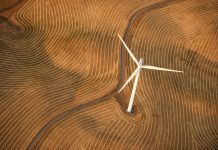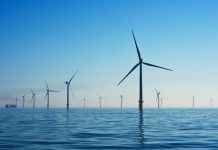Wind energy has become a staple of the United States energy mix with more than 150 GW installed capacity at the end of 2023. Looking to the future, the American Clean Power Association projects that up to 109-GW more land-based wind capacity may be installed by 2030.
LCOE and Influencing Factors
Levelized cost of energy (LCOE) is a measure of the lifetime costs to operate a turbine divided by the total energy production. The goal is to reduce LCOE by either decreasing the total lifetime cost or increasing the energy output or both. The total cost of the turbine includes both initial purchase and erection of the site (CapEx) and lifetime operating and maintenance costs (OpEx). The National Renewable Energy Laboratory (NREL) estimates that OpEx accounts for 26 percent of the predicted total lifetime cost [1]. After the site is constructed and brought online, the operators only have influence of these OpEx costs. Some of these costs can be forecasted, such as scheduled maintenance, but others, such as drivetrain failures, cannot. It is important operators catch failures early before they turn into something more costly.

Premature Failures
When selecting a bearing, the designer considers the applied load, load rating, and target life. This effort results in selection of a bearing size that will not fail from rolling contact fatigue in the raceways for the target design life.
In most industries, it is well known that when a bearing fails, only 3 to 5 percent of these have failed because of this rolling contact fatigue, when the remaining 95 to 97 percent of them fail from other issues, such as contamination, poor lubrication, inadequate structure, mishandling, poor installation, etc. Unfortunately, wind is no different. According to a publication from NREL, “The dominant failure modes of the drivetrain components and the conditions that lead to their failure are not fully accounted for during product design or routinely modeled for life management.”[2]
Premature failures of the main shaft bearings and gearbox are among the leading causes of downtime in onshore wind turbines [3]. The blade bearings have been playing an increasing role in the last couple of years. (Figure 1)
Even though the bearings may have been sized correctly for the applied raceway loads, it is the other factors that lead to the premature failures experienced in wind. According to a report from EPRI [4], some primary causes of gearbox bearing failures include:
- Macro-pitting due to skidding, bearing slippage.
- Wear due to inadequate lubrication.
- Race cracking due to white etch formation.
- Low-quality materials and material defects/inclusion.
- When purchasing replacement bearings, it is advisable to pursue upgraded bearings that can address these failure modes for improved reliability.

Investing in upgrades to lower total cost of ownership
Original equipment manufacturers (OEMs) typically design their equipment using the most economical part available to meet the requirements. This keeps total equipment costs down, but as premature failures are discovered, investigated, and understood, upgraded bearings can typically be offered to improve the life in the application.
The upgraded bearings recommended could include additional coatings, alternative materials, and heat treatments or even have a completely different internal design. These recommendations are made case-by-case to address the failure modes found on that platform, gearbox model, or even by specific position within the gearbox. A natural outcome of these bearing enhancements is a higher price, reflecting their higher manufacturing costs. Although purchasing the same bearing as supplied with the original equipment likely has a lower purchase price, it is also likely that reinstalling the same bearing will result in another premature failure leading to multiple replacements through the life of the turbine. Rather than focusing on upfront cost, it is important to understand the total cost of ownership (TCO).
For Example
If a high-speed shaft (HSS) bearing in a gearbox is being replaced every three years, it could have six or more replacements through the 20- to 25-year turbine life. Bearing manufacturers have heavily researched the causes of the non-fatigue related failure modes such as white etching-cracking (WEC) a.k.a. white structure failure (WSF) and solutions that prevent failure completely or prolong life in these applications are known and already running in wind-turbine gearboxes successfully for years. In this case, if it was discovered this bearing was failing from WEC, there is the opportunity to extend the life by more than seven times against this failure mode. (Figure 2)
Each time the bearing fails, the turbine is derated or shut down, reducing total energy output portion of the LCOE calculation. Additionally, the repair contractor will have to be hired, mobilize, ship any special tooling, etc. This can increase the OpEx costs portion of the LCOE calculation. As a result, this job may cost about $20,000, not including downtime revenue loss.

Scenario 1: Install same bearing again ~3-year life
- Total replacement cost: $120,000 ($20,000 x 6 occurrences).
- Accumulated downtime: $12,000 ($2,000 per day x 6 occurrences).
- Total cost of ownership (TCO) of original bearing: $132,000.
Scenario 2: Install upgraded bearing with 7x life
- Total replacement cost: $22,000 ($22,000 x 1 occurrence).
- Accumulated downtime: $2,000 ($2,000 per day x 1 occurrence).
- Total cost of ownership (TCO) of upgraded bearing: $24,000.
- Total savings: $108,000 per turbine.
This $108,000 savings comes at the cost of a $2,000 added bearing cost on the upfront purchase. This $2,000 upgraded bearing adder amounted to less than a 10-percent increase on the upfront total job scope cost and is paid back over 50 times through the remaining life of the turbine. (Figure 3)
Another important factor to consider is every additional bearing failure makes the turbine vulnerable to additional failures such as sudden catastrophic failure or damage to other components in the system.
For example, each time a gearbox is opened and reassembled, it introduces more operational vulnerabilities such as introduction of debris or damage of other components, so elimination of the additional repairs also inherently improves reliability. This increased reliability is harder to monetize but can be thought of as sleep insurance, easing operator concerns about that turbine.

Supply Chain Partners
When purchasing new bearings to replace those prematurely failed, contact an authorized bearing distributor with experience in the wind industry, such as Malloy.
The benefit of working with Malloy is knowledge of the industry and application. The company has deployed and has in inventory many solution-based bearings as described. Also, one solution does not necessarily apply to all applications, so industry experience can be a guide to select and apply the correct upgrade for the specific application, balancing between upgrades where needed for improved life, but not applying them when not needed unnecessarily, which can inflate the cost.
Collaboration with a knowledgeable and experienced supply chain partner will help reduce the TCO of bearings in a wind turbine and in turn help minimize LCOE. (Figure 4)
References
- Tyler Stehly, Patrick Duffy, and Daniel Mulas Hernando. 2022 Cost of Wind Energy Review. NREL. [Online] December 2023. https://www.nrel.gov/docs/fy24osti/88335.pdf.
- Wind Turbine Drivetrain Reliability and Wind Plant Operatiosn and Maintenance Research and Development Opportunities. NREL. [Online] September 2021. https://www.nrel.gov/docs/fy21osti/80195.pdf.
- Wind Turbine Reliability Data Review and Impacts on Levelised Cost of Energy. Durham University Research Online. [Online] December 31, 2019. https://durham-repository.worktribe.com/output/1297348/wind-turbine-reliability-data-review-and-impacts-on-levelised-cost-of-energy.
- Wind Turbine Gearbox Reliability Assesment. EPRI. [Online] December 2021. https://www.epri.com/research/programs/113055/results/3002021422.



























